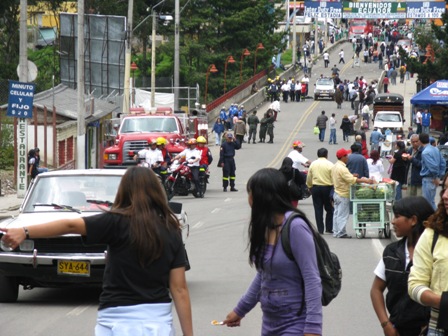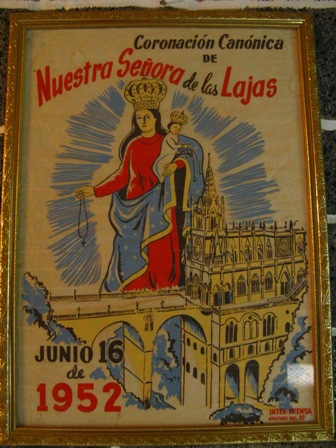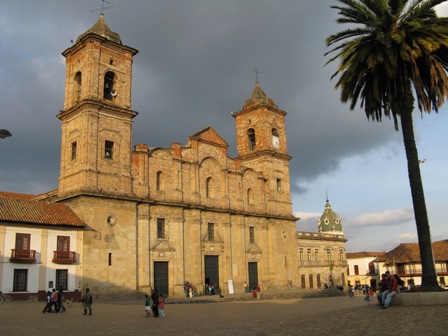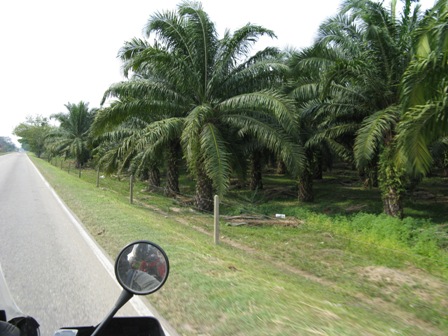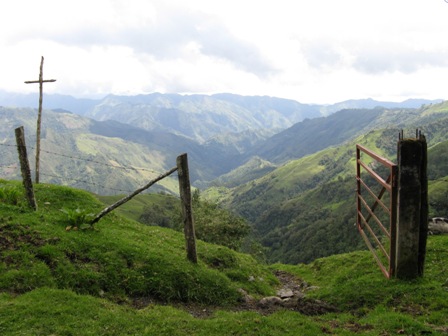Cruisin' through Colombia
A busy border crossing, after a march for peace (see previous blog)
Colombia is famous for being dangerous, having very friendly people, a passion for football, music, coffee and beautiful women. In the last couple of years the government of Alvaro Uribe has really cracked down on the FARC, the guerilla group who've been wreaking terror on the country for years, and now Colombia is safer than ever. This much we'd heard from other bikers and first impressions gave nothing to dispell this. The frequent roadblocks of military police, army or transport police give one a sense of security. We'd been told that sticking to the main roads meant you'd be fairly safe (if you avoid the hurtling trucks around every corner, that is).
Ipiales, on the Ecuadorian/Colombian border was a typical border town - unattractive, edgy and busy. We usually avoid them. We headed East for a few kilometres to Las Lajas where a church was built in amazing style across a gorge. A young girl and her mother, Maria Mueses, reportedly saw a vision of the virgin in 1754 and over the years the sanctuary grew to its present gothic brilliance.

Las Lajas
Las Lajas by night
Some of the miracles attributed to the virgin of Las Lajas - each plaque is a 'thank you'
A wonderful old poster in the museum
We found a place to stay in an old monastery; a tiny cell with hard beds and monkish austerity. As the only guests we felt quite priviledged, especially with the wonderful views of the Sanctuario from our room.
I'm not sure we're pure enough, but they let us stay
Mindful of our deadline, to leave Colombia by the end of March, we pushed on the following morning. The plan was to ride to Medellin so Hame could work on the bike and collect parts he'd ordered at Ruta 40, the BMW workshop. Poor Bertha's frame had cracked again. She also needed new brake pads and a good service.
Back on the PanAm!
Bertha, green hills
With our tight deadline we just about had time to spend a few days In Medellin fixing the bike, then two weeks making a loop around the country. Not much, and not the way we usually like to travel (like snails), but better than nothing.
Lovely view on the way to Popayan
This landslide wiped out a service station
Delivering the milk, 1
Flower shop, Popayan
We had a great ride to Popayan, lots of twisties and hills which kept Hame smiling. Popayan itself was a graceful old city full of colonial architecture and atmosphere.
Colonial architecture
Stopping off the following night in Calarca, we contacted JuanEs and Paula, the couple we'd met in Peru when JuanEs's spokes broke. We'd been in touch with them about visiting Medellin.
I called Paula and told her we were on the way. "But you can't come next week," she said. "It's Semana Santa and everything's closed!"
Semana Santa is "Holy Week", the days leading up to Easter. Paula told us Ruta 40 would be shut the entire week and that we shoud change our plans. Fortunately we're good at that so we looked at our tiny map, got out the highlighter, and drew a squiggly line around the country, taking in all the places we wanted to see.
And so began our mad '3000 or so km in 12 days' dash around Colombia!
A very green country
The coffee region was beautiful. On leaving Calarca we made a loop through a valley which was just stunning. On the way I heard a strange noise coming from the bike and mentioned it to Hame. Now, blokes don't like to be told there's something wrong with their toys, so when I told him the response was something like, "Ofcoursethere'snotdon'tbedaft." So I shut up.
A little further down the road when we stopped for fuel, Hame glanced at the brakes and said a bad word. One of the pads we'd had made in Ecuador ("Only seven dollars!") had dropped out and the strange noise I'd heard was the sound of metal on metal.
I kept quiet and offered him a muesli bar.
Luckily there was a Frenos (brakes) workshop just down the road so we stopped in and got it sorted. With creatively fixed brakes we rode on in search of a bed for the night.
Riveting those brake pads
Just like new!
We stopped in Chinchina, a small village in the coffee growing region. We passed a sign saying "Coffee Hacienda, tours" and popped in to enquire. Immediately we fell in love with the views, serenity and swimming pool, and stayed two days. Seider took us on a tour of the plantation and Jorge demonstrated how to dry, roast and grind the coffee. Mmmm! The hacienda had been in Maria Thersa's, (Jorge's mother) family for years and it was a lovely family place which was hard to leave.
Seider begins his tour of the plantation
Baby coffee plants
Us and Seider - he's one of the happiest blokes I've ever met!
Ripe coffee beans
And at the end, we had a great cuppa
Awww, do we HAVE to leave...?
In Chinchina Hame was mobbed by curious locals while I popped into the local supermarket!
Hame's in there somewhere
With Maria Theresa and Jorge
Delivering the milk, 2 (great video of this guy on our youtube page)
Refreshed and with a great coffee buzz we said farewell and rode on to Zipaquira, home of one of the "Wonders of Colombia" - the Salt Cathedral. It was amazing - a huge cathedral dug out of the salt deposits underground, with crosses, altar and even the font made from salt.
Fruit market in Zipaquaira
The main plaza in Zipaquaira
Semana Santa parade, Zipaquaira (we never quite worked out what the KKK-like uniforms were all about)
Military parade, Zipaquaira
Stopping in rural town Oiba for the night we met Mariella in the street who was incredibly helpful and showed us a cheapy hotel and a great eatery run by a friend of hers. We spent a fun night with Mariella, her friend and their daughters, and a soldier called Tom Cruise, who hung his ammunition belt on the back of my chair.
Hame wth Mariella, her friend and daughters
Oiba
View from the "Good View" hotel (it also had pillows that were torture devices, but at only two quid a night, who's complaining!)
Guns are a common sight in Colombia, either held cowboy style as policemen ride helter-skelter through the streets on a bike, or on everyone manning the many roadblocks. I got used to it after a while, but it was strange to see kids - many of the soldiers looked like teenagers - holding guns almost as big as they were.

Friendly police
As we dropped down from the mountains the weather got hotter and hotter. We sweltered away in our gear, utterly unused to the heat after months of temperate climates. In Aguachica we found a hotel which was wonderfully cheap but had a fan which had only one speed - helicopter. It was impossible to sleep with it on but too hot without. We found the solution by lying naked under wet towels.
Trying to keep the diesel fumes out
The road straightened and the next morning we found ourselves on a straight run for the coast, past palm oil plantations and fields of munching brahman cattle. The heat was intense. We stopped for a juice at a roadside stall. It came in a bucket!
Like a spade with that??
Roadside juice bar
Palm oil plantation
The locals had all been really friendly. Occasionally we'd meet grumpy hotel owners who didn't thank us for attempts to bargain the price, but generally people were fantastic. Many people seemed surprised that we were alone and asked us, "But haven't you heard how dangerous Colombia is?" It seemed they were all aware of the reputation Colombia has and lived mindful of the violence in the past, when it was too dangerous to travel alone and bandits or guerillas ruled the highways.
A holy bus
Many people also told me my Spanish was good, though I suspect that this is because they're unused to tourists and therefore anyone who can put two words together is seen as "good"! I have definitely improved though, Hamish too, and I really enjoy speaking the language.
Yet another amazing view
We rode on towards the coast, past crazy holiday traffic and the inevitable accidents. The heat seemed to get worse as we went and by the time we arrived at the coast in the small village of Taganga we were both ready to get our gear off.
Taganga from above
Because of the holiday most hotels were full and the empty ones were rubbish, but we got lucky when we met German Thomas in the street. He told us that the dive centre where he worked might have a room. Sure enough, it did and we gratefully stripped off our gear and went for a sunset beer on the beach, and a mini-celebration upon reaching the northern coast of South America. It seemed a very long time since we left Ushuaia....
Caribbean sunset
The following day we went diving in the Caribbean! The water was surprisingly cold but there was lots to see and we had a good time. I could have stayed to dive longer, however the unstoppable clock was ticking and we had to leave.
Attack of the cone-heads
Someone's got a really huge head
Riding along the North coast brought us to Cartagena, once the most ransacked cities in the Americas. The Spanish used it as a base from which to export goods they'd "acquired" from the continent. Francis Drake was one of the toughest pirates to beat and he made many successful attacks against the city. In the end a submarine wall was built to prevent him entering the natural harbour.
The old city is surrounded by impressive fortress walls and the new city is a modern town full of tall and glittery buildings. We got a room in the old town, in a place which turned into one big party in the evenings (we must be getting old). heading out for lunch we settled down to eat. Another couple strolled in and asked if they could share our table. Gloria and her husband Alveiro were friendly and we chatted over our food. Afterwards they asked us if we'd like a stroll along the walls and around the old town. We soon became friends and they asked if we'd like to meet the following day.

Old town Cartegena

Fernando Botero sculpture - Colombia's most famous artist

Em and Alveiro walk along the fortress walls
After surviving another night of noise and parties, we were picked up by Alveiro early the next morning for a game of tennis. I played in Malaysia but wasn't great, and after a gap of two years during which time I've done bugger all exercise I was in pretty bad shape. But it was great fun!

Proof that sport is bad for you
Afterwards they took us to a beach East of town where we swam, ate wonderful local fish and soaked up the music-filled Caribbean atosphere.

The beach menu - with Gloria and Alveiro
Gloria and Alveiro invited us back anytime we were in Cartagena, we thanked them politely but said we'd be leaving by plane from Medellin. They were great people and we were bowled over by their hospitality.
Early the next morning we started on the loop South again, and rode back to the mountians with a brief stop on the way. It was a blessed relief to be back in cooler climes, even if it did mean a return to the rain.
On arrival in Medellin we headed to Casa Kiwi where Paul the friendly owner (and biker) told me it wasn't quiet - at least he was honest! By now sleep had become something I was missing greatly as we'd been moving fast, changing beds every night and not getting much rest, plus riding long days every day. It was great as we'd seen lots of the country, but isn't the way we like to travel. We were both shattered actually. Paul kindly pointed us in the direction of a quiet and peaceful hostel around the corner. We found Hostel Tamarindo, run by the very lovely Natalie, and it was like being at home. We both had stuff to do - I was on a mission to organise flights to Panama and Hame had to work on the bike. He spent three days working flat out while I practised Spanish on the phone with various agents.
(Emma)
Having established yet another crack around the shock mount whilst in Ecuador, by the time we reached Medellin, it was high time to solve the issue. The local brake pads had got us this far, but I wasn't going to risk any more mishaps, so they were to be replaced. My $2 forkseals from Lima were showing their worth and no longer retaining oil and the rattling tappets were telling me it was time for a decent service.

Cracked again!
Mauricio, owner of local BMW dealer, Ruta 40, is a motorcycle traveller himself, having ridden the length of the Americas some years ago and is therefore sympathetic to us motorcycling vagabonds. He therefore very kindly let me use the workshop for three days to carry out what was neccessary.

Ruta 40 Workshop
As it's now the fourth time I've had to repair the sub-frame, it was off within an hour, welded by lunchtime and back on that afternoon.

Repaired frame
I took the opportunity to address the cause of the cracking frame (no, I didn't tell Em to catch the bus!), by replacing the worn rear shock absorber spring. The spring which had taken us from Australia had had enough, regularly "bottoming out" and therefore transferring all shock loads to the frame directly instead of absorbing them.

New spring
Fortunately Ruta 40 had a replacement Ohlins and although not the perfect size or fit, when there's a will, there's a way! Suffice to say we now have suspension! I finished the job off with a very technical cover - a cut-off sock! Much to the amusement of the in house mechanics.

Andreas and "Shock-Sock"!
After replacing the brake pads, fork seals and a good service, all that remained was to re-grease the shaft drive. When we stripped it in Bolivia after our rather eventful crossing of the Salar de Uyuni, the only grease I could find was regular multi-purpose stuff. Not exactly recommended by the boys from Bavaria. So off the shaft came for a re-greasing. Just as well I did, as it tuned out the gear-box output shaft seal was weeping and would only have got worse, so we took the opportunity to replace it when the shaft was out.
By the end of three days I was beginning to think we had a new bike, if it wasn't for the gleeming new 1200's lined up in the showroom that is. You can keep 'em, Bertha's part of the family now!
Mauricio, Philipe (Workshop Manager) and Andreas (Cheif Mechanic) were indeed top blokes and helped us out a treat - thanks guys!

Hame with Philipe and Andreas
(Hame)
It was good to catch up with JuanEs and Paula once again. They took us out and showed us a good time - we enjoyed the week very much.

With Paula and JuanEs
All my investiagtions into flying came up blank - it was stupidly expensive and hassle-filled so we changed plans again and decided to take a boat from Cartagena. Hame had picked up details from the noticeboards in our hotel - every week there are private boats leaving for Panama. We'd heard a fair few horror stories about this trip but thought we'd found someone good - we made contact with Guido and arranged to meet him on Sunday night back in Cartagena.
I contacted Gloria and Alveiro who were both delighted we were coming back and offered us a bed for the night.
We set off from Medellin at five o'clock after an unsuccessful attempt at an early night - we met Dave, a British biker and of course we all had stories to tell. Both exhausted, we rode all day and arrived in Cartagena 13 hours later! It was about 700 km altogether.

Delivering the milk, 3

More friendly coppers
We met with Guido and arranged to put the bike on board the following day. Right away we both liked him and the other passengers seemed like good folks.
After a pleasant evening with Gloria and Alveiro we left with Bertha the next morning and loaded her onto the boat. The Seeadler was a comfortable looking boat which had been Guido's home for the past 15 years. With the help of a couple of guys we managed to get Bertha on board from the fuel station (that's the royal 'we' again, I took pictures).

Loading the bike, 1, with Guido and Leo

Loading the bike, 2

Add a tarp, job done!
We loaded up with beer and rum, bought some snacks and boarded the Seeadler in the afternoon. Our papers took ages to arrive so we left as the sun dropped.

Farewell, South America....
Hame and I sat on deck and watched South America receding into the distance, reflecting on what an incredible 16 months it's been. We were also feeling full of excitement at the trip ahead - five days cruising through the Caribbean!

Our route through South America
There are a few more videos on our youtube page - click below to see them.
Next blog - Panama and beyond!
(Emma)
Pics of the month:
Chasing the sun
Bertha's restaurant!

What, no dirt bikes?!

At least they're honest


